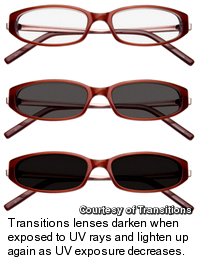 EQUIPMENT REVIEW
EQUIPMENT REVIEW
Transitions lenses protect eyes (and wallets) of golfers who wear glasses
By Kiel Christianson,
Senior Writer
Over the past season, I've been sneaking out to play nine quick holes in the late evenings, and a good number of holes on the front side of my home course face directly into the setting sun. I cannot see my ball at all when it flies into the heart of the sun, and because my accuracy is, well, less than predictable, this has resulted in more lost balls and less fun.
Why don't I wear sunglasses? Well, I wear regular glasses, and I can't find sunglasses to fit over my regular glasses without making me look like my late grandmother when she went out for a Sunday drive. And, frankly, prescription sunglasses are far too expensive for the limited utility they would provide.
|
Recently, though, I was clued in to the flexibility and practicality of Transitions lenses. These are the prescription lenses that darken automatically in response to UV rays and lighten back up again when you go inside. So I decided to try them as a solution to my late-day golfing woes.
How Transitions lenses work
Transitions lenses have been around for over a decade, and before I got mine, I spoke with a few golfers who had tried them when they first appeared on the market. The consensus was that the lenses performed well on the golf course but took too long to lighten up indoors. In addition, they didn't darken enough (or at all) when driving in the car, as most UV rays are filtered out these days by auto glass.
When being fitted for my Transitions, I was told by the technician that the new generation of lenses lighten up considerably faster than the previous designs. The second issue wasn't a concern for me, as I don't wear sunglasses when I drive anyway.
The third issue is the cost: Transitions lenses run around $80-$100 more than traditional lenses, but this is over $200 less than a pair of prescription sunglasses. In essence, you get two pairs of glasses in one with Transitions, so the somewhat higher price feels reasonable.
Transitions lenses: The verdict
I've played several rounds now with my Transitions lenses and have been generally impressed. They allow me to keep an eye on my ball in all but the most blinding conditions, which makes my late-day round far more enjoyable. Even when not facing the sun, I seem to be able to follow my ball against the blue sky much more accurately, cutting down considerably on time spent stomping through the rough.
When it comes to reading the greens, the darker lenses don't seem to hurt or help - basically, I can't tell any difference either way. And when the round is over, and it's time to hit the 19th hole, the lenses lighten up completely within a couple of minutes, which doesn't bother me personally at all. (Years spent in dimly lit dives have apparently inured me to temporary murkiness.)
The one downside to Transitions lenses comes on partly cloudy days, when stretches of bright sun are broken up by sudden walls of thick, fast-moving clouds. On one such day, I stood addressing my ball when gray clouds passed overhead. Suddenly, it was hard to see my ball. It felt like a Biblical plague of darkness, and I began looking around for locusts or frogs. Well, not quite. But I did have to step away from my ball and let my eyes get used to the shade (and allow the lenses to lighten up a bit).
Nevertheless, on those bright, cloudless, relentlessly sunny days, Transitions lenses are an excellent option for golfers who, for whatever reason, avoid sunglasses.
For more information, visit www.en-us.transitions.com.
November 18, 2008
Any opinions expressed above are those of the writer and do not necessarily represent the views of the management.